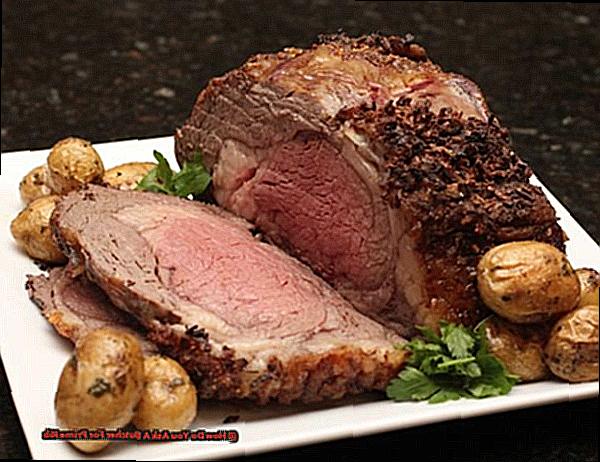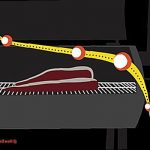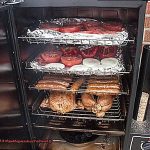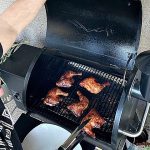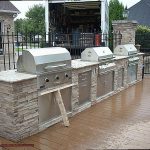Are you craving a mouth-watering prime rib dinner with your loved ones? Look no further. However, before you get too excited, it’s crucial to know how to ask a butcher for prime rib. Don’t worry if you’re new to the game; we’ve got you covered.
The secret to an unforgettable prime rib meal is securing the perfect cut of meat. But how do you ensure that you’re getting the best quality? It all starts with understanding the different grades of beef and knowing precisely what to ask your butcher.
Butchers are experts in their field and are always happy to help shoppers find the perfect cut. However, prime rib can go by several names, so it’s essential to know which terms to use and which questions to ask. In this post, we’ll guide you through everything you need to know about asking a butcher for prime rib confidently.
Whether it’s your first time or not, there’s no denying that prime rib is a show-stopping meal that will leave everyone impressed. So sit back, relax, and let us teach you how to make sure your next dinner party is one for the books.
Contents
What is Prime Rib?
Prime rib is a cut of beef that is highly sought after for its unparalleled tenderness and flavor. This succulent cut is taken from the rib section of a cow, specifically ribs six through twelve, and is sometimes referred to as a standing rib roast. What sets prime rib apart from other cuts of beef is its marbling, which comes from the intramuscular fat that runs throughout the meat. This marbling translates to a buttery texture and rich, beefy flavor that is hard to resist.
The USDA grading system ranks beef based on its quality, with prime being the highest grade. However, not all prime rib is necessarily prime grade, with choice and select grades also available. When purchasing prime rib, it’s important to specify the number of ribs needed and to ask about the grade of meat. For the best possible flavor and tenderness, opt for prime grade beef.
When it comes to cooking prime rib, there are a variety of methods to choose from. It can be roasted in the oven or grilled over an open flame. Regardless of how you choose to prepare it, there are a few tips to keep in mind for the perfect result. Firstly, allow the meat to come to room temperature before cooking to ensure even cooking throughout. Secondly, season generously with salt and pepper or your preferred seasoning blend. Finally, use a meat thermometer to ensure that it reaches your desired level of doneness.
How Much Do You Need?
Firstly, consider the number of people you will be serving and their appetites. To ensure that everyone gets their fill, a good rule of thumb is to plan for about 1 pound of prime rib per person. However, if you want leftovers or have particularly hungry guests, it’s always better to err on the side of caution and purchase more.
Secondly, make sure to communicate your needs clearly with your butcher. They can help you choose an appropriate size and cut of prime rib based on the number of guests and any other relevant details. Keep in mind that prime rib is often sold by the bone, so discuss with your butcher if you need it cut before purchase. This can affect the amount of meat you ultimately end up with, so trust their recommendations.
Lastly, aim for prime grade beef to ensure maximum flavor and follow our cooking tips for a show-stopping meal that will leave your guests raving.
Where to Buy Prime Rib
First up, your local butcher shop is a great option. These shops source their meat from local farms and provide a personalized shopping experience. Additionally, their knowledgeable staff can help you choose the best cut of prime rib for your needs and even custom cut it to your desired specifications.
For those who prefer the convenience of online shopping, numerous online meat retailers offer high-quality cuts of meat and different grades of prime rib. However, be sure to do your research before ordering to ensure that you’re getting a quality product. Reading reviews is an excellent way to ensure satisfaction.
If you’re looking for something truly unique and special, consider visiting a specialty meat market or ordering directly from a farm. Though pricier, these options offer the highest quality and most unique cuts of meat that won’t be found in your local grocery store.
No matter where you choose to buy your prime rib, always ask questions about the source and quality of the meat. A good butcher or retailer will happily share their knowledge with you to ensure that you’re getting the best possible product.
In summary, here are some key takeaways on where to buy prime rib:
- Local butcher shops offer personalized shopping experiences and high-quality meat.
- Online meat retailers offer convenience but require research beforehand.
- Specialty meat markets and direct ordering from farms offer unique and high-quality cuts of meat.
- Always ask questions about the source and quality of the meat to ensure satisfaction.
Choosing the Right Cut and Grade of Meat
Choosing the right cut and grade of meat is crucial for a mouthwatering and unforgettable meal. As an expert in selecting the perfect prime rib, I have some valuable tips to help you make the right choice.
The first step is to understand the different grades of beef available. Prime, Choice, and Select are the most common grades you will find at your local butcher shop or grocery store. Prime is the highest quality grade, with abundant marbling and tenderness that melts in your mouth. Choice offers a balance between quality and affordability, while Select is leaner and less expensive. Whichever grade you choose, be sure to specify it to your butcher.
Next, consider the cut of meat you want. The prime rib comes from the cow’s rib section and is usually sold bone-in. The size of the cut can vary depending on how many ribs are included, ranging from two to seven bones. Tell your butcher how many people you are serving and what size cut you need for your occasion.
When it comes to seasoning and cooking methods, don’t hesitate to ask your butcher for advice. They are experts in their field and can recommend the best seasonings and cooking techniques to bring out the flavors of your prime rib. Whether you prefer a classic rub or a unique marinade, your butcher can guide you towards success.
Asking the Butcher for Prime Rib
Not only are they experts in their field, but they can also provide you with valuable knowledge and advice on selecting the best cut of meat for your needs.
Firstly, it’s important to understand what prime rib actually means. This cut of beef is taken from the rib section of the cow and is known for its rich flavor and tenderness. When asking your butcher for prime rib, be sure to communicate your preferences regarding size, weight, and doneness.
But perhaps the most crucial factor in selecting the perfect prime rib is understanding the grading system used by butchers. Prime grade meat is considered to be the highest quality and boasts the highest amount of marbling. This marbling enhances both flavor and tenderness. Choice grade meat is also high-quality but has less marbling than prime, while select grade meat is leaner and can be tougher if not cooked properly.
So, when approaching your butcher, request a prime or choice grade prime rib. In addition to communicating your desired weight and size of the cut, don’t forget to mention any preferences you may have regarding the level of doneness.
But that’s not all – make sure to discuss any special instructions or requests you may have for preparing the prime rib. For instance, if you plan on dry-aging the meat at home or have specific seasoning preferences, let your butcher know so they can provide you with a suitable cut.
Getting Advice from the Butcher
If you’re feeling intimidated by the thought of cooking the perfect prime rib, don’t worry. You can get expert advice from a butcher to make all the difference. Butchers are masters in their field and can provide valuable information on selecting the best cuts of meat, cooking times, and temperatures to ensure your dish turns out perfectly every time.
To start, it’s essential to find a reputable butcher with an excellent reputation. Ask for recommendations from friends or family members, or do some research online to find the best butchers in your area. Once you’ve found a suitable option, come prepared with a list of questions.
When speaking with the butcher, honesty is key – let them know if you’re new to cooking prime rib and ask for their recommendations on the best cuts for beginners. They can also advise on the size of the cut you need based on how many people you’ll be cooking for.
It’s crucial to consider the cooking method when getting advice from a butcher. Whether you plan on roasting, grilling, or smoking your prime rib, let the butcher know and ask for their recommendations on the best cooking times and temperatures.
Butchers may also have insider tips and seasoning recommendations that can take your dish to the next level. Don’t be afraid to ask if they have any additional tricks up their sleeve.
Cooking Tips for Prime Rib
Cooking a prime rib can seem intimidating, but with the right tips and techniques, it can be a breeze. Here are some steps to ensure that your prime rib is cooked to perfection.
Choosing the Right Cut:
The first step to cooking the perfect prime rib is choosing the right cut. A bone-in prime rib is the most popular and flavorful cut, but it can be more difficult to carve. A boneless prime rib is easier to carve and cook evenly, but it may not have as much flavor. It’s worth asking your butcher for their recommendations on which cut to choose and how much you will need for your group size.
Preparing the Meat:
Before cooking, it is important to let the meat come to room temperature for at least an hour. This allows the meat to cook evenly and avoids any tough spots. Additionally, seasoning the meat with salt and pepper before cooking will enhance its natural flavor.
Cooking Temperature:
Cooking the prime rib to the perfect temperature is crucial for a tender and juicy result. A good rule of thumb is to cook the meat at 325°F for about 15-18 minutes per pound for medium-rare. However, using a meat thermometer will ensure that you achieve the desired temperature. Insert the thermometer into the thickest part of the meat, being careful not to touch any bones.
Resting Time:
After cooking, it’s important to let the meat rest for at least 15-20 minutes before carving. This allows the juices to redistribute throughout the meat, ensuring that every slice is moist and flavorful. Cover the prime rib with foil while it rests to keep it warm.
Carving:
When it comes time to carve, use a sharp carving knife and slice against the grain of the meat. This ensures that every bite is tender and easy to chew. If you’re new to carving prime rib, it’s worth watching some videos or practicing on a smaller cut before the big day.
Conclusion
To sum up, prime rib is a delectable and highly coveted beef cut that’s ideal for any special occasion or dinner gathering. However, to get the perfect cut, it’s crucial to know how to ask your butcher for it. This includes comprehending the different beef grades, communicating your requirements clearly with your butcher, and selecting the right cut and grade of meat.
Moreover, seeking advice from your butcher on cooking methods, seasoning recommendations, and carving techniques can make all the difference in achieving an impressive outcome. Whether you choose to roast or grill your prime rib, allowing it to reach room temperature before cooking, generously seasoning with salt and pepper or your desired blend, and using a meat thermometer to ensure proper doneness are all vital tips for success.
Lastly, where you purchase prime rib is also crucial. Local butcher shops offer personalized shopping experiences and high-quality meat. Online retailers provide convenience but require research beforehand. Specialty meat markets and direct ordering from farms offer unique and high-quality cuts of meat that won’t be found in your local grocery store.

